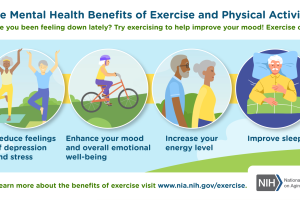The Connection Between Exercise and Mental Health: What You Need to Know

Overview of Mental Health
Mental health encompasses emotional, psychological, and social well-being. It influences how individuals think, feel, and act. Understanding mental health is essential, as it affects daily life and overall happiness. Many experience mental health issues at some point, which may include:
- The Connection Between Exercise and Mental Health: What You Need to Know
- Overview of Mental Health
- Importance of Exercise
- How Exercise Impacts Mental Health
- Release of Endorphins
- Reduction of Stress
- Types of Exercise That Benefit Mental Health
- Aerobic Exercise
- Strength Training
- Mind-Body Connection in Exercise
- Yoga and Meditation
- Tai Chi and Qi Gong
- Exercise as a Tool for Managing Mental Health Conditions
- Depression and Anxiety
- PTSD and ADHD
- Incorporating Exercise into Your Mental Health Routine
- Setting Realistic Goals
- Finding Enjoyable Activities
- The Role of Social Support in Exercise and Mental Health
- Group Fitness Classes
- Exercise Buddies
- Overcoming Barriers to Exercise for Better Mental Health
- Time Constraints
- Physical Limitations
- Creating a Balanced Approach to Exercise and Mental Health
- Rest and Recovery
- Seeking Professional Guidance
- Conclusion
- Anxiety disorders
- Depression
- Bipolar disorder
Recognizing the importance of mental health is the first step in fostering a supportive environment for discussions and awareness.
Importance of Exercise
Exercise plays a crucial role in maintaining mental health. When individuals engage in physical activity, it can lead to substantial improvements in mood and emotional state. Personally, many find that going for a jog or participating in a dance class alleviates stress and boosts their spirits. The benefits of exercise include:
- Release of endorphins: These “feel-good” hormones improve mood.
- Improved sleep: Regular exercise helps regulate sleep patterns, which is vital for mental clarity.
- Increased self-esteem: Achieving fitness goals can enhance self-confidence.
By integrating exercise into daily routines, one can significantly enhance their mental wellness.
How Exercise Impacts Mental Health
Release of Endorphins
One of the most fascinating aspects of exercise is its ability to trigger the release of endorphins, often referred to as the body’s natural painkillers. These chemical messengers provide a sense of euphoria and happiness, commonly associated with the “runner’s high.” Many find that even a brisk walk or a quick workout session can uplift their mood significantly. Consider this:
- Duration: Just 20-30 minutes of exercise can produce noticeable endorphin release.
- Activities: While running is popular, even dancing or playing sports can be incredibly effective.
Reduction of Stress
In addition to boosting happiness, regular exercise is a powerful tool for stress reduction. Physical activity helps to lower levels of the body’s stress hormones, such as cortisol. Engaging in exercise allows individuals to channel their frustrations and anxieties in a productive manner. Personal stories often highlight this transformation. For example:
- After a stressful day at work, hitting the gym or practicing yoga can provide a much-needed mental reset.
- Social exercising, like group classes, not only addresses stress but fosters a sense of community.
By embracing exercise as a routine practice, the potential for mental clarity and resilience against stress becomes even greater.
Types of Exercise That Benefit Mental Health
Aerobic Exercise
Aerobic exercise, often referred to as cardio, includes activities like running, cycling, and swimming. These exercises elevate the heart rate and breathe new life into both the body and mind. Personally, many individuals report that after a 30-minute jog or a spirited Zumba class, they feel lighter, more energized, and mentally clearer. The benefits of aerobic exercise include:
- Enhanced mood: Regular cardio has been linked to reduced feelings of anxiety and depression.
- Better sleep: Improved cardiovascular health contributes to a more restful night’s sleep, which is vital for mental health.
Strength Training
While aerobic exercises are well-known for mental health boosts, strength training also deserves recognition. Activities such as weight lifting or resistance workouts not only build physical strength but also enhance mental toughness. The sense of accomplishment from lifting heavier weights can significantly boost self-esteem. Consider these points:
- Focus and discipline: Strength training requires concentration, which can serve as a mental break from daily stressors.
- Routine familiarity: Consistent strength workouts create a sense of stability, which can be comforting amidst life’s unpredictability.
Incorporating both aerobic and strength training into a fitness routine offers a comprehensive approach to bolstering mental health.
Mind-Body Connection in Exercise
Yoga and Meditation
The mind-body connection is profoundly strengthened through practices like yoga and meditation. These exercises emphasize mindfulness and intentional breathing, creating a serene space for mental clarity. Many people share how, after completing a yoga session, they feel a deep sense of relaxation and tranquility that lingers throughout their day. Key benefits of yoga and meditation include:
- Stress reduction: Mindful breathing during yoga helps lower cortisol levels, alleviating stress.
- Enhanced focus: Engaging in meditation cultivates better concentration, beneficial in everyday activities.
Practitioners often recount feeling more in tune with their bodies, allowing for improved emotional regulation.
Tai Chi and Qi Gong
Tai Chi and Qi Gong are similar practices that draw from ancient Chinese traditions, focusing on slow, deliberate movements and deep breathing. Many find these exercises refreshingly gentle yet incredibly effective for mental well-being. Some advantages of Tai Chi and Qi Gong include:
- Balance and coordination: These exercises improve physical balance, which correlates with mental stability.
- Mindfulness in motion: Practitioners often experience a meditative state during movements, enhancing overall mental calmness.
By incorporating yoga, meditation, Tai Chi, and Qi Gong into fitness routines, individuals can foster a profound mind-body connection, paving the way for holistic mental health improvements.
Exercise as a Tool for Managing Mental Health Conditions
Depression and Anxiety
Exercise serves as a powerful ally in managing mental health conditions like depression and anxiety. Numerous studies show that regular physical activity can significantly lift mood and reduce anxiety levels. Many individuals who struggle with these conditions often find that a brisk walk or a cycling session helps clear their minds and elevate their spirits. Consider these benefits:
- Natural antidepressant: Exercise releases endorphins and serotonin, which can improve feelings of happiness and well-being.
- Routine establishment: Creating a regular workout schedule provides structure, which is often beneficial for those dealing with depression.
PTSD and ADHD
For individuals with PTSD and ADHD, exercise can also be incredibly beneficial. While the thought of confronting past traumas can feel overwhelming, engaging in consistent physical activity offers a sense of empowerment and control. Benefits for PTSD and ADHD include:
- Stress relief: Exercise can mitigate symptoms of hyperarousal and anxiety commonly associated with PTSD.
- Improved focus: For those with ADHD, regular physical activity can help enhance attention span and concentration levels.
Incorporating exercise into daily routines not only promotes physical health but also serves as a vital tool in managing various mental health conditions, fostering resilience and hope in the journey toward recovery.
Incorporating Exercise into Your Mental Health Routine
Setting Realistic Goals
Integrating exercise into a mental health routine begins with setting realistic goals. It’s important not to overwhelm oneself; instead, start small and gradually build up. For example, committing to just ten minutes of walking each day can be a manageable goal that yields significant benefits over time. Tips for setting achievable goals:
- Be specific: Instead of saying, “I want to exercise more,” try “I will walk for 15 minutes three times a week.”
- Track progress: Keeping a journal or using a fitness app can help maintain motivation and track improvements.
Finding Enjoyable Activities
Choosing activities that are enjoyable makes it much easier to stick with an exercise routine. When individuals engage in fun workouts, it doesn’t feel like a chore. Many people have found joy in various forms of exercise, from dancing to hiking or joining community sports teams. Consider these points when exploring activities:
- Mix it up: Try different classes, such as kickboxing or yoga, to discover what resonates best.
- Socialize: Invite friends to join, making exercise a social experience can enhance the fun factor.
Incorporating these strategies ensures that exercise becomes a positive, reinforcing aspect of enhancing mental health.
The Role of Social Support in Exercise and Mental Health
Group Fitness Classes
Social support plays a vital role in maintaining a consistent exercise routine and enhancing mental health. Group fitness classes are a fantastic way to combine physical activity with social interaction. Whether it’s a high-intensity spin class or a calming yoga session, being surrounded by others can boost motivation and accountability. Benefits of group fitness include:
- Sense of community: Engaging with others fosters camaraderie, making workouts more enjoyable.
- Shared experiences: Everyone in the class is on a similar journey, creating a supportive environment where instructors and participants encourage one another.
Exercise Buddies
Having an exercise buddy can provide that extra push needed to stay committed. Motivating each other to adhere to workout plans can turn mundane workouts into fun social outings. Here are some advantages of exercising with a buddy:
- Accountability: You’re less likely to skip a workout if someone else is counting on you.
- Increased enjoyment: Sharing the experience can make physical activity more engaging and less isolating.
Integrating social aspects into exercise routines not only amplifies motivation but also creates a strong support network essential for mental well-being.
Overcoming Barriers to Exercise for Better Mental Health
Time Constraints
One of the most common barriers to exercise is time constraints. In today’s fast-paced world, many individuals feel they simply don’t have enough hours in the day to prioritize physical activity. However, even small adjustments can lead to significant outcomes. Some strategies to overcome time limitations include:
- Short workouts: Consider quick, high-intensity sessions that are only 20-30 minutes long; they’re often just as effective.
- Combine activities: Integrate exercise into daily routines, such as walking or biking to work or opting for stair climbing instead of the elevator.
Physical Limitations
Physical limitations can also serve as an obstacle to maintaining an active lifestyle. Many may feel discouraged by injuries, chronic pain, or other health issues. However, it’s essential to remember that exercise can be adapted to suit individual needs. Ways to work around physical limitations include:
- Gentle exercises: Activities like swimming, yoga, or chair workouts can be effective without causing strain.
- Consulting professionals: Engaging with a physical therapist or personal trainer can help tailor a fitness plan that accommodates any constraints.
By identifying and addressing these challenges, individuals can pave the way for incorporating exercise into their lives, further enhancing their mental health journey.
Creating a Balanced Approach to Exercise and Mental Health
Rest and Recovery
While engaging in regular exercise is vital for mental health, it’s equally crucial to prioritize rest and recovery. Overtraining can lead to burnout and physical injuries, which ultimately detracts from the mental health benefits sought through exercise. Here are some key considerations for rest and recovery:
- Listen to your body: Pay attention to signs of fatigue and allow yourself downtime when needed.
- Incorporate rest days: Set aside at least one full day each week to let your muscles heal and rejuvenate.
Rest isn’t just a break from physical activity; it’s an essential component of a balanced fitness regimen that supports well-being.
Seeking Professional Guidance
For those looking to create a well-rounded exercise plan tailored to their mental health needs, seeking professional guidance can be invaluable. Trainers, therapists, and fitness coaches can provide personalized advice based on individual goals and limitations. Consider these benefits of professional support:
- Expertise: A certified trainer can help design a program that considers both physical and mental health.
- Motivation: Regular sessions can keep you accountable and inspired to reach your fitness milestones.
By integrating rest and seeking appropriate guidance, individuals can cultivate a balanced approach to exercise that enhances their mental health journey effectively.
Conclusion
As we’ve explored throughout this article, exercise profoundly impacts mental health, providing numerous emotional and psychological benefits. From releasing endorphins to fostering social connections, the importance of maintaining an active lifestyle cannot be overstated. Reflecting on these key points, consider the following:
- Physical Activity: Regular exercise, whether aerobic, strength training, or restorative practices like yoga, nurtures mental well-being.
- Community: Social support, through fitness classes or exercise buddies, can enhance motivation and create a sense of belonging.
- Balance: Remembering the importance of rest and seeking professional guidance help to build a sustainable exercise routine that supports your mental health.
Incorporating these strategies into daily life can lead to significant improvements in mental clarity, resilience, and overall happiness. Ultimately, the journey toward mental health is ongoing, and even small steps can lead to transformative results. So, lace up those sneakers and embrace the empowering journey of exercise for better mental health!





